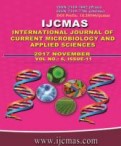


 National Academy of Agricultural Sciences (NAAS)
National Academy of Agricultural Sciences (NAAS)

|
PRINT ISSN : 2319-7692
Online ISSN : 2319-7706 Issues : 12 per year Publisher : Excellent Publishers Email : editorijcmas@gmail.com / submit@ijcmas.com Editor-in-chief: Dr.M.Prakash Index Copernicus ICV 2018: 95.39 NAAS RATING 2020: 5.38 |
Genetic diversity assessment for agro morphological traits in a population can be estimated by different methods such as univariate and multivariate analysis. Multivariate analysis is utilized for analyzing more than one variable at once. A diversed collection of 192 genotypes with traditional landraces and exotic genotypes from 12 countries was evaluated for 12 agro- morphological traits by multivariate analysis which reveals the pattern of genetic diversity and relationship among individuals. Twelve quantitative characters i.e. plant height, leaf length, number of productive tillers, panicle length, number of filled grains, spikelet fertility, days to 50% flowering; days to harvest maturity, grain length, grain width, grain length width ratio, and single plant yield were measured. Multivariate techniques such as UPGMA cluster analysis, principal component analysis and canonical vector analysis was utilized to examine the variation and to estimate the relative contribution of various traits for total variability. Analysis by UPGMA method had clustered 192 genotypes into seven clusters. Principal component analysis had shown the genetic diversity of the population panel. The cumulative variance of 80.56% of total variation among 12 characters was explained by the first five axes. Canonical discriminant analysis indicated that the first two functions accounted for more than 86% of total variance and the traits such as days to 50% flowering, maturity, grain characters, panicle length and plant height were identified as principal discriminatory characters. These analyses have indicated the presence of variation in the population panel which can be utilized for various crop improvement programs.
 |
 |
 |
 |
 |